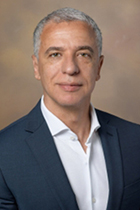Welcome to the Division of Cardiology at the University of Arizona College of Medicine – Tucson.
I am excited and honored to lead this renowned clinical division, which has a long and outstanding history of clinical excellence, education and discovery. Our division is in the midst of an exciting era or rapid growth. We pride ourselves in the exceptional clinical care that we provide in diverse and highly complex areas of cardiology. Our mission is to deliver outstanding clinical cardiovascular care, to educate the next generation of leaders in cardiovascular medicine, and to lead the way in transformative medical discoveries and innovations.
Despite significant medical advances, cardiovascular diseases remain the leading cause of death and disability worldwide. In the United States, CVDs are responsible for over 750,000 deaths annually, making it the leading cause of death in the country. In a recent American Heart Association report, it is predicted that over half of the U.S. population will have some form of CVD by 2035. These staggering numbers pose a remarkable challenge to the entire health care system, and we at the Division of Cardiology at the U of A are poised and determined to make a positive impact on cardiovascular health.
As a leading academic cardiovascular division, we hold ourselves to the highest possible standards of patient care. Through our partnership with Banner – University Medical Center Tucson, the premier medical center in Tucson, we deliver outstanding cardiac care in a wide range of disciplines including cardiovascular prevention, women’s cardiovascular diseases, coronary artery diseases, acute and chronic heart failure, genetic cardiomyopathies, acute coronary syndromes, valvular heart diseases and arrhythmias, among others. We are expanding our clinical services to meet the demands of our patients as they arise by adopting and spearheading cutting-edge medical innovations.
Many of our faculty members are national and international leaders in cardiovascular medicine in a broad range of disciplines. Our faculty are members of editorial boards and associate editors of top medical journals, and are members, fellows and leaders of numerous renowned cardiovascular, medical and biomedical organizations and societies such as the American Heart Association, American College of Cardiology, and American Society for Clinical Investigation – one of the oldest U.S. honorary medical societies – to name a few.
Education and training are at the forefront of our mission. Our fellowship program attracts outstanding candidates from top academic institutes across the country. We have over 20 cardiology fellows pursuing training in general cardiology and subspecialty training in electrophysiology, imaging and interventional cardiology. We are tremendously proud of our fellows and our fellowship program, and we are committed to training the next generation of leaders in cardiovascular medicine through our partnership with Banner Health and the Sarver Heart Center.
The Division of Cardiology at U of A has contributed to cutting-edge medical innovations and discovery for more than four decades. Our division is the birthplace of artificial hearts, where the world’s first such device was implanted. We are also the birthplace of chest compression only CPR, an innovative lifesaving technique which was pioneered by cardiologists here. CCO-CPR has gone on to save innumerable lives following cardiac arrest, and has been adopted by the American Heart Association, American College of Cardiology, European Society of Cardiology and various medical societies and organizations as a first-line lifesaving measure for out of hospital cardiac arrest. More recently, faculty members in our division have invented the next generation total artificial heart, which promises to transform the care of heart failure patients. Our faculty and fellows continue to pursue transformative medical innovations through investigator-initiated clinical trials and partnership with industry.
As we look towards the future, we have developed an ambitious plan to continue to provide the best cardiovascular care for our community, and to build an internationally renowned cardiovascular program that offers state-of-the-art innovative therapies to our patients from Arizona, the U.S. and around the world.
 Hesham A. Sadek, MD, PhD
Hesham A. Sadek, MD, PhD
Chief, Division of Cardiology
Director, Sarver Heart Center
Professor of Medicine
Member of the Graduate Faculty
University of Arizona Department of Medicine, College of Medicine – Tucson


